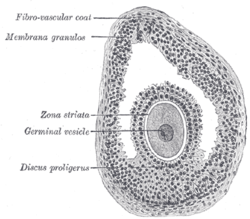| Cumulus oophorus | |
|---|---|
 Section of vesicular ovarian follicle of a cat. X 50. (Discus proligerus labeled at lower left.) Section of vesicular ovarian follicle of a cat. X 50. (Discus proligerus labeled at lower left.) | |
| Details | |
| Identifiers | |
| Latin | cumulus oophorus discus proliger |
| FMA | 18659 |
| Anatomical terminology[edit on Wikidata] | |
The cumulus oophorus (discus proligerus) is a cluster of cells that surround the oocyte both in the ovarian follicle and after ovulation. In the antral follicle, it may be regarded as an extension of the membrana granulosa. The innermost layer of these cells is the corona radiata.
This layer of cells must be penetrated by spermatozoa for fertilization to occur.
Functions
Functions of the cumulus oophorus include coordination of follicular development and oocyte maturation. Mechanisms of the latter include stimulation of amino acid transport and sterol biosynthesis and regulation of oocyte gene transcription.
It also provides energy substrates for oocyte meiotic resumption and promotes glycolysis.
Cumulus oophorus cells contribute heavily to the maturation and eventual fertilization of an oocyte. As a follicle grows in size and the antrum develops, more layers of cumulus oophorus cells accumulate around the oocyte to aid in the acrosome reaction and sperm penetration into the oocyte. The proximity between the cumulus oophorus cells and the oocyte favors bidirectional communication, which is vital for oocyte development.
Gene expression profiling
As a part of the process of in vitro fertilization, gene expression profiling of cumulus cells can be performed to estimate oocyte quality and the efficiency of an ovarian hyperstimulation protocol, and may indirectly predict oocyte aneuploidy, embryo development and pregnancy outcomes. Increased knowledge in these aspects is useful in, for example, embryo selection.
In gene expression profiling of cumulus cells, genes where increased expression is correlated with higher oocyte competence or better pregnancy outcomes, include: HAS2, GREM1 and PTGS2.
In contrast, genes where increased expression is correlated with lower oocyte competence or worse pregnancy outcomes include: BDNF, CCND2, CXCR4, GPX3, HSPB1, DVL3, DHCR7, CTNND1, TRIM28, STAR, AREG, CX43, PTGS2, SCD1 and SCD5.
References
- Gilbert, Scott F. Developmental Biology (Ninth ed.). Sinauer Associates, Inc. p. 126. ISBN 978-0878933846.
- ^ The Evian Annual Reproduction (EVAR) Workshop Group 2010; Fauser, B. C. J. M.; Diedrich, K.; Bouchard, P.; Domínguez, F.; Matzuk, M.; Franks, S.; Hamamah, S.; Simón, C.; Devroey, P.; Ezcurra, D.; Howles, C. M. (2011). "Contemporary genetic technologies and female reproduction". Human Reproduction Update. 17 (6): 829–847. doi:10.1093/humupd/dmr033. PMC 3191938. PMID 21896560.
{{cite journal}}: CS1 maint: numeric names: authors list (link)
External links
- Anatomy photo: Reproductive/mammal/ovary5/ovary3 - Comparative Organology at University of California, Davis - "Mammal, bovine ovary (LM, Medium)"
- Swiss embryology (from UL, UB, and UF) dbefruchtung/objectbefru01
- UIUC Histology Subject 366
- Histology image: 18404loa – Histology Learning System at Boston University - "Female Reproductive System: ovary, cumulus oophorus"
| Female reproductive system | |||||||||||||||||||||||||||||||
|---|---|---|---|---|---|---|---|---|---|---|---|---|---|---|---|---|---|---|---|---|---|---|---|---|---|---|---|---|---|---|---|
| Internal |
| ||||||||||||||||||||||||||||||
| External |
| ||||||||||||||||||||||||||||||
| Blood supply | |||||||||||||||||||||||||||||||
| Other | |||||||||||||||||||||||||||||||